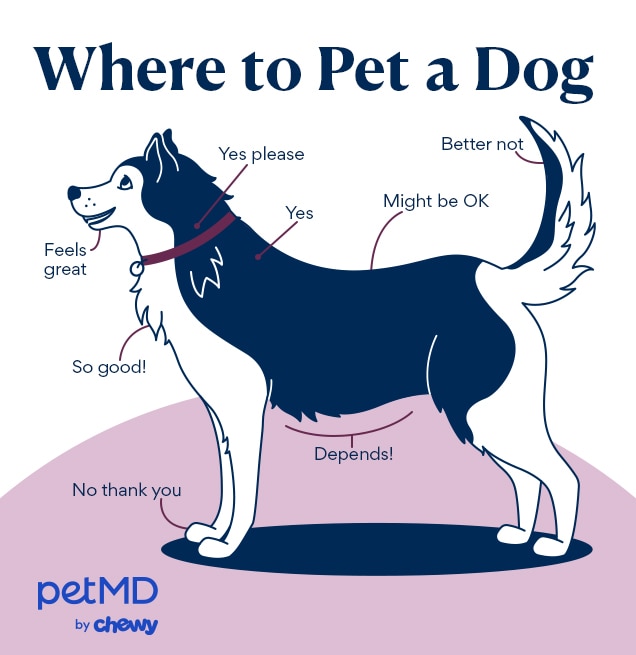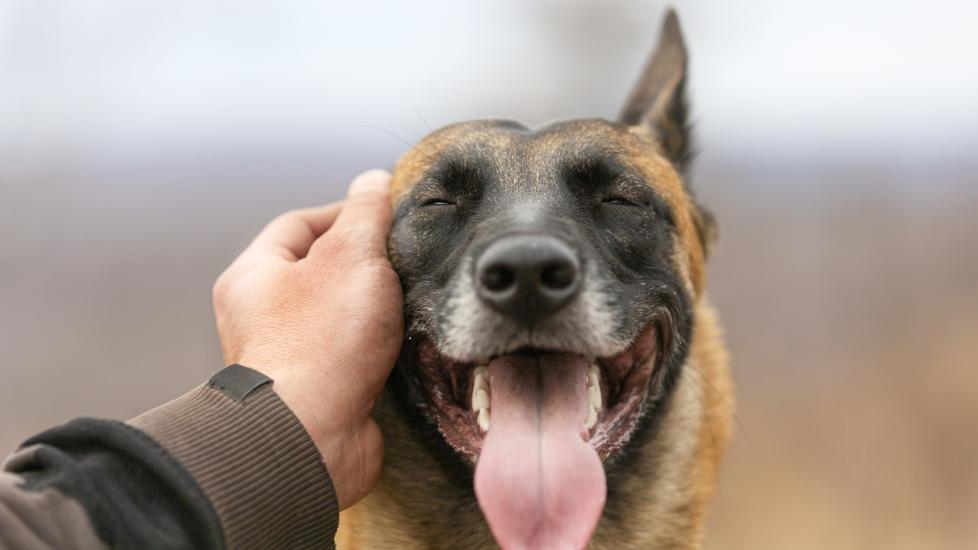How to Pet a Dog Properly
Dmitry Belyaev/iStock / Getty Images Plus via Getty Images
The saying “first impressions count” applies not only to people, but also to interactions with pets. When meeting a dog for the first time, it’s important to make the interaction a positive event for both you and the dog.
When it comes to petting, there’s a general misconception that people have the right to pet any dog.
Do Dogs Like Being Pet?
Dogs can have individual preferences on when and how they want to interact with people. Some friendly dogs may enthusiastically welcome any type of attention from anyone, anywhere, and anytime. But some dogs don’t want to interact with random strangers at all.
So how do we know when a dog is open to receiving attention? Here are some signs to look for:
-
Soft, relaxed body language, such as loose lips, a loose and relaxed tail, soft eyes, and relaxed facial features
-
The dog may move forward toward you when you speak to them
-
The dog maintains eye contact with you
Signs a dog wants to be left alone may include:
-
A tucked tail
-
Lip-licking
-
Avoiding eye contact
-
Whale eyes (being able to see the white of the eye)
-
Ears pulled to the side or all the way back
-
Body weight shifted backward
-
Creases at the corner of the mouth
-
Furrowed brows
-
Lowered head
-
Body in a slight crouch
If you notice any of these signs, give the dog space and don’t attempt to pet them.
How to Pet a Dog
If you see a dog you’d like to pet, follow these steps for a successful interaction.
1. Ask the Pet Parent
Always ask the pet parent if their dog is friendly and receptive to being pet by a stranger. Start the conversation before you’re directly in front of the dog so they have space to check you out.
Even if the pet parent gives consent, take a few seconds to look at the dog’s body language to see if the dog is indeed receptive to attention. Not all dogs are comfortable interacting with strangers or want attention from anyone other than their family members.
2. Approach the Dog
If soft body language is present, speak in a soft, quiet voice without giving the dog a hard and direct stare. You can make brief eye contact and look away, or look at the dog out of the corner of your eye and check how receptive they are.
Position your body so you’re standing sideways, and make sure there’s 3–4 feet of space between you and the dog. You can crouch or kneel with a knee on the ground, but avoid bending and looming over the dog. This can make many dogs uncomfortable. Slightly extend your hand, but keep it loose and by your side—not in front of the dog’s face. This indicates that you’re inviting social interaction.
3. Let the Dog Approach You
Now it is the dog’s turn to approach to receive attention—if they want to. With a slightly extended hand, the dog can move forward to sniff. Because your hand is loose by your side, once the dog has sniffed it and appears receptive, you can reach forward and pet under the dog’s chin.
Many dogs do not like to be pet on top of the head by strangers, because a hand reaching toward their head can be perceived as a threatening gesture. By reaching under the dog’s head, you’re sending a message that you’re not a threat.
4. See How the Dog Responds
Gently pet the dog once or twice and slowly withdraw your hand. This is a consent test; it’s your way of asking the dog, “Hello, is this OK with you and do you want more?” This allows the dog the choice to move away if they are uncomfortable.
If the dog moves closer and continues to stand in front of you, give additional pets and speak in a soothing voice. If the dog continues to be receptive, you can move to stroke other areas such as their neck or chest. Dogs may be more receptive to strokes versus short pats on their body. Strokes can be soothing, whereas having hands touch the body on and off repeatedly can be annoying and intrusive.
Every dog is an individual, so the reaction to petting may differ among the canines you encounter. Some pups are enthusiastic to receive pets and may wag their tail or nudge your hand for more. Other dogs may be more reserved and stand quietly or retreat slightly before coming back for more pets.
Every dog is an individual, so the reaction to petting may differ among the canines you encounter.
If the dog stiffens or pulls away, do not reach toward them anymore. Their body language indicates they are done or overwhelmed by too much attention. Slowly withdraw your hand, take a few steps back, and slowly stand up again. People who do not give a dog enough space or suddenly stand up can trigger a fear response. This can cause the dog to bark, jump back, or cower.
Where Do Dogs Like To Be Pet?

Do not automatically assume that all dogs like to be pet on the top of their head. This is a learned behavior. Many dogs are receptive to being pet on top of their head by their pet parents because they have learned to like the attention and contact. They may also accept petting on top of their head from familiar people they have met multiple times.
Most dogs are receptive to pets in areas such as:
-
Under the chin
-
Along the side of the neck
-
On the shoulders
-
On the chest
Go slow when petting along the top of a dog’s back. Some dogs may like it, but others may not.
Avoid reaching for the dog’s paws, tail, ears, lips, or stomach, even if the dog rolls over on their back. A common misconception is that the dog is asking for a belly rub when they roll over, but this is not always true.
When a dog rolls over on their back, stop giving them attention and take a few steps back to give them space. While some dogs like belly rubs from their family, they might not like a stranger touching this vulnerable part of their body.
Remember: It’s never wrong to go slow with an unfamiliar dog to win them over and make a good first impression. Take the time to read their body language and go slowly for a pleasant interaction—for you and the dog.
